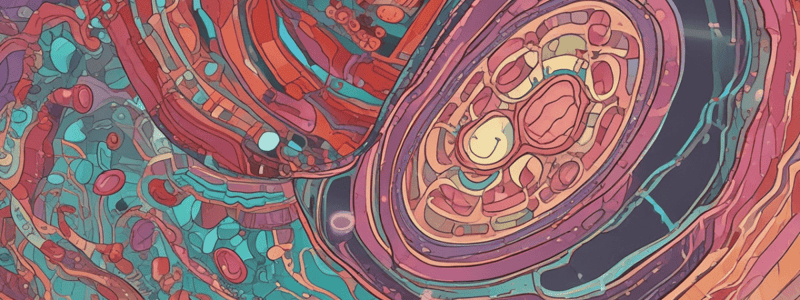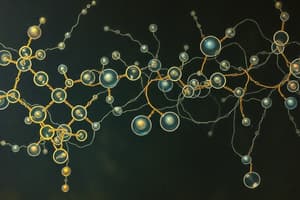Podcast
Questions and Answers
What is the primary function of the TOM complex?
What is the primary function of the TOM complex?
- To synthesize mitochondrial proteins in the cytosol
- To recognize signal sequences of mitochondrial proteins (correct)
- To degrade misfolded mitochondrial proteins
- To transport proteins from the intermembrane space to the mitochondrial matrix
Which of the following machinery is responsible for the import of nucleus-encoded mitochondrial proteins?
Which of the following machinery is responsible for the import of nucleus-encoded mitochondrial proteins?
- TIM 5 translocator of the inner mitochondrial membrane
- MIM 5 mitochondrial import machinery (correct)
- SAM 5 sorting and assembly machinery
- TOM 5 translocator of the outer membrane
Where are the mitochondrial proteins initially transported to after being recognized by the TOM complex?
Where are the mitochondrial proteins initially transported to after being recognized by the TOM complex?
- Mitochondrial matrix
- Intermembrane space (correct)
- Outer mitochondrial membrane
- Cytosol
What determines the different itineraries of mitochondrial proteins after being transported into the intermembrane space?
What determines the different itineraries of mitochondrial proteins after being transported into the intermembrane space?
Which of the following is NOT a component of the mitochondrial import machinery?
Which of the following is NOT a component of the mitochondrial import machinery?
What is the role of protein translocators in the mitochondrial membranes?
What is the role of protein translocators in the mitochondrial membranes?
What is the primary function of signal sequences in mitochondrial precursor proteins?
What is the primary function of signal sequences in mitochondrial precursor proteins?
What is the role of signal peptidase in the import of mitochondrial proteins?
What is the role of signal peptidase in the import of mitochondrial proteins?
Where are protein translocator complexes located in mitochondria?
Where are protein translocator complexes located in mitochondria?
How many different precursor proteins do protein translocators direct to their appropriate sub-compartment in mitochondria?
How many different precursor proteins do protein translocators direct to their appropriate sub-compartment in mitochondria?
What controls which translocator(s) a precursor protein engages and the order in which the signals are used?
What controls which translocator(s) a precursor protein engages and the order in which the signals are used?
What is the primary function of protein translocators in mitochondrial membranes?
What is the primary function of protein translocators in mitochondrial membranes?
What is the primary function of peroxisomes in eukaryotic cells?
What is the primary function of peroxisomes in eukaryotic cells?
What is the byproduct of oxidation reactions in peroxisomes?
What is the byproduct of oxidation reactions in peroxisomes?
How are fatty acid molecules broken down in peroxisomes?
How are fatty acid molecules broken down in peroxisomes?
What is the destination of acetyl CoA produced in peroxisomes?
What is the destination of acetyl CoA produced in peroxisomes?
How are integral membrane proteins of the peroxisomal membrane delivered?
How are integral membrane proteins of the peroxisomal membrane delivered?
What is the function of the sequence Ser-Lys-Leu in peroxisomal proteins?
What is the function of the sequence Ser-Lys-Leu in peroxisomal proteins?
What is required for peroxisomal protein import?
What is required for peroxisomal protein import?
Which peroxin recognizes C-terminal peroxisomal sorting signals?
Which peroxin recognizes C-terminal peroxisomal sorting signals?
What is the function of Pex7 in peroxisomal protein transport?
What is the function of Pex7 in peroxisomal protein transport?
What is a unique feature of the peroxisomal protein translocator?
What is a unique feature of the peroxisomal protein translocator?
What is the primary function of mitochondria?
What is the primary function of mitochondria?
Where are most mitochondrial proteins encoded?
Where are most mitochondrial proteins encoded?
What is the space between the inner and outer mitochondrial membranes called?
What is the space between the inner and outer mitochondrial membranes called?
How are new mitochondria produced?
How are new mitochondria produced?
What is the function of the cristae in mitochondria?
What is the function of the cristae in mitochondria?
What is the significance of the different sub-compartments in mitochondria?
What is the significance of the different sub-compartments in mitochondria?
What is the primary function of the OXA complex?
What is the primary function of the OXA complex?
What is the role of chaperones of the hsp70 family in protein import by mitochondria?
What is the role of chaperones of the hsp70 family in protein import by mitochondria?
Where are mitochondrially encoded membrane proteins assembled with nuclear-encoded membrane proteins?
Where are mitochondrially encoded membrane proteins assembled with nuclear-encoded membrane proteins?
What is the mechanism of protein import by mitochondria?
What is the mechanism of protein import by mitochondria?
What is the function of the MIM complex?
What is the function of the MIM complex?
What is the characteristic of mitochondrial precursor proteins after synthesis?
What is the characteristic of mitochondrial precursor proteins after synthesis?
What is the role of the TIM complex?
What is the role of the TIM complex?
What is the fate of mitochondrially encoded membrane proteins and nuclear-encoded membrane proteins?
What is the fate of mitochondrially encoded membrane proteins and nuclear-encoded membrane proteins?
Flashcards are hidden until you start studying
Study Notes
The Transport of Proteins into Mitochondria
- Mitochondria are double membrane-enclosed organelles that specialize in ATP synthesis using energy derived from electron transport and oxidative phosphorylation.
- Although mitochondria have their own DNA, ribosomes, and other components required for protein synthesis, almost all of their proteins are encoded in the cell nucleus and imported from the cytosol.
- Each imported protein must reach the particular organelle sub-compartment in which it functions.
Mitochondrial Sub-compartments
- The inner mitochondrial membrane encloses the matrix space and forms extensive invaginations called cristae.
- The outer mitochondrial membrane is in contact with the cytosol.
- The intermembrane space is the space between the inner and outer membranes, subdivided into the crista space and intermembrane space, with protein complexes at the junctions where the cristae invaginate.
- Each sub-compartment contains a distinct set of proteins.
Protein Import into Mitochondria
- Signal sequences direct all mitochondrial precursor proteins to their appropriate mitochondrial sub-compartment.
- One or more signal sequences are necessary and sufficient for the import and correct localization of proteins.
- Protein translocators in the mitochondrial membranes recognize particular types of signals and direct ~1500 different precursor proteins from the cytosol to the appropriate sub-compartment of mitochondria.
- The TOM complex is required for the import of nearly all nucleus-encoded mitochondrial proteins.
- The TOM complex recognizes signal sequences and transports them from the cytosol into the intermembrane space.
Peroxisomes
- Peroxisomes are major sites of oxygen utilization and are found in virtually all eukaryotic cells.
- Peroxisomes contain oxidative enzymes, such as catalase and urate oxidase, at high concentrations.
- Peroxisomes use molecular oxygen and hydrogen peroxide to perform oxidation reactions.
- Peroxisomes break down fatty acid molecules through β oxidation, converting fatty acids to acetyl CoA.
Protein Import into Peroxisomes
- Integral membrane proteins of the peroxisomal membrane are first inserted into the ER and then packaged into specialized peroxisomal precursor vesicles.
- Peroxisomal proteins can be imported directly from the cytosol into preexisting peroxisomes.
- A specific sequence of three amino acids (Ser-Lys-Leu) at the C-terminus of many peroxisomal proteins functions as an import signal.
- Peroxisomal protein import is driven by ATP hydrolysis and utilizes a collection of proteins called peroxins.
- The protein translocator in the peroxisomal membrane is composed of at least six different peroxins.
Studying That Suits You
Use AI to generate personalized quizzes and flashcards to suit your learning preferences.




